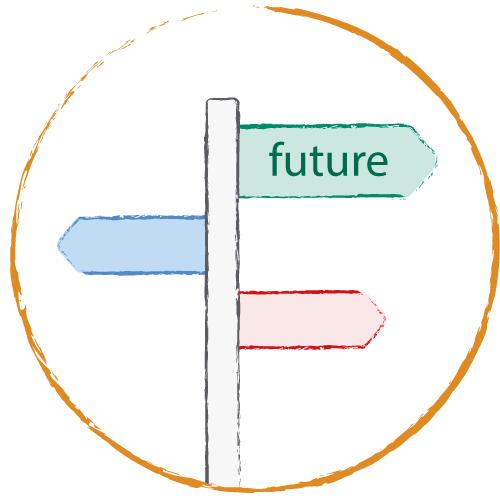Future application
Proposing future application
The final section of a studio knowledge object speculates about how you can transfer this new knowledge to future projects and professional practice. The aim is to develop your design expertise by applying lessons learned from this studio and from your structured reflection.

What is the value of these insights to your fields of interest?

What are the implications of your insights for your future practice?

Will they influence your career direction?
Examples
Questions
Example paragraph structure
In the Design for Social Change studio I have changed my approach to design from a focus on things to a focus on ways. My role as a designer has become clearer through a more profound understanding of the need to create systems and strategies. I have been challenged to see how my creativity and unique way of thinking can be used to create deeper human meaning and connectedness through applying the six spheres of sustainability, using empathy to determine better connectedness, and using feedback as part of the design process. So much of my previous design education has taught me that to be a designer is to make things. I no longer think that. I feel liberated to know that through these new ways of being, doing and living I can create a career for myself as a designer who can make a difference.
Structure
Questions to ask:
- What aspect/s of the learning in this studio will you drawn on for future design practice? (Learning)
- What techniques will you transfer to your future practice? (Techniques
- What meaning and value does this have for your practice? (Meaning/value)
- How might you apply this understanding to your future practice (Apply)
[Learning] In the Design for Social Change studio I have changed my approach to design from a focus on things to a focus on ways. [End learning] [Techniques] My role as a designer has become clearer through a more profound understanding of the need to create systems and strategies. I have been challenged to see how my creativity and unique way of thinking can be used to create deeper human meaning and connectedness through applying the six spheres of sustainability, using empathy to determine better connectedness, and using feedback as part of the design process. [End techniques] [Meaning/value] So much of my previous design education has taught me that to be a designer is to make things. I no longer think that. [End meaning/value] [Apply] I feel liberated to know that through these new ways of being, doing and living I can create a career for myself as a designer who can make a difference. [End apply]
Language features
Features
- Use ‘I’ to demonstrate your personal and subjective response to the field of practice
- A reflective paragraph identifies a change in learning over time from the past to the present/future
[Past learning] In the Design for Social Change studio I have changed my approach to design from a focus on things to a focus on ways. My role as a designer has become clearer through a more profound understanding of the need to create systems and strategies. I have been challenged to see how my creativity and unique way of thinking can be used to create deeper human meaning and connectedness through applying the six spheres of sustainability, using empathy to determine better connectedness, and using feedback as part of the design process. So much of my previous design education has taught me that to be a designer is to make things. [End past learning] [Future practice] I no longer think that. I feel liberated to know that through these new ways of being, doing and living I can create a career for myself as a designer who can make a difference. [End future practice]
Questions
Example paragraph structure
I foresee a continued exploration of principles from the field of interpretation design in my future design practice, focusing on context and perspective. The interpretive environment brief allowed me to test different narratives and communication aims for the same exhibit at the Melbourne Museum. I now appreciate that a practitioner needs to look further afield than mere graphic identity and aesthetic integration, towards strategies and frameworks to achieve the aims of the exhibition. I have come to understand the benefit of creating different narratives that target specific ages and audiences for the same exhibit. Carefully designed environments and experiences use the principles of interpretation design to target an exhibition's narrative, its communication aims and its effectiveness, as well as its audience's needs, the degree of interaction and approach to learning. This strategy significantly improves final outcomes. I will continue to investigate interpretation design, specifically exhibition design in relation to child-centred design strategies. I will concentrate on being mindful of the context and perspective of the information being depicted to create more engaging, inspiring and educational outcomes.
Structure
Questions to ask:
- What aspect/s of the learning in this studio will you drawn on for future design practice? (Learning)
- What techniques will you transfer to your future practice? (Techniques
- What meaning and value does this have for your practice? (Meaning/value)
- How might you apply this understanding to your future practice (Apply)
[Learning] I foresee a continued exploration of principles from the field of interpretation design in my future design practice, focusing on context and perspective. [End learning] [Techniques] The interpretive environment brief allowed me to test different narratives and communication aims for the same exhibit at the Melbourne Museum. I now appreciate that a practitioner needs to look further afield than mere graphic identity and aesthetic integration, towards strategies and frameworks to achieve the aims of the exhibition. [End techniques] [Meaning/value] I have come to understand the benefit of creating different narratives that target specific ages and audiences for the same exhibit. Carefully designed environments and experiences use the principles of interpretation design to target an exhibition's narrative, its communication aims and its effectiveness, as well as its audience's needs, the degree of interaction and approach to learning. This strategy significantly improves final outcomes. [End meaning/value] [Apply] I will continue to investigate interpretation design, specifically exhibition design in relation to child-centred design strategies. I will concentrate on being mindful of the context and perspective of the information being depicted to create more engaging, inspiring and educational outcomes. [End apply]
Language features
Features
- Use ‘I’ to demonstrate your personal and subjective response to the field of practice
- A reflective paragraph identifies a change in learning over time from the past to the present/future
[Future practice] I foresee a continued exploration of principles from the field of interpretation design in my future design practice, focusing on context and perspective. [End future practice] [Past learning] The interpretive environment brief allowed me to test different narratives and communication aims for the same exhibit at the Melbourne Museum. [End past learning] [Future practice] I now appreciate that a practitioner needs to look further afield than mere graphic identity and aesthetic integration, towards strategies and frameworks to achieve the aims of the exhibition. [End future practice] [Past learning] I have come to understand the benefit of creating different narratives that target specific ages and audiences for the same exhibit. [End past learning] Carefully designed environments and experiences use the principles of interpretation design to target an exhibition's narrative, its communication aims and its effectiveness, as well as its audience's needs, the degree of interaction and approach to learning. This strategy significantly improves final outcomes. [Future practice] I will continue to investigate interpretation design, specifically exhibition design in relation to child-centred design strategies. I will concentrate on being mindful of the context and perspective of the information being depicted to create more engaging, inspiring and educational outcomes. [End future practice]
Questions
Example paragraph structure
A critical incident for me was realising that, as a designer I need to be thinking about strategies that have lasting impact. When we were first told about our task in the studio, Design for Social Change, I was extremely cynical that I would be able to develop a strategy for communicating the importance of climate change and food security to young people. This kind of pessimism prevented me from thinking clearly about how to make a change. Taking the time to actually look at successful projects and campaigns that promote sustainable and socially just ideals, made me realise that complex design tasks are achievable if we connect the right problem with the right audience in a way that hasn’t been tried before. This is what I learnt from looking at case studies and what inspired my own strategy to use personas and the six spheres approaches. Knowing that communicating anything is perfectly achievable as long as you understand who you’re talking to is probably the most important thing that I’ve learnt this semester. It has given me confidence that this field of practice is not futile and that I can continue to develop my skills in systems thinking for social innovation and sustainable design strategies.
Structure
Questions to ask:
- What aspect/s of the learning in this studio will you drawn on for future design practice? (Learning)
- What techniques will you transfer to your future practice? (Techniques
- What meaning and value does this have for your practice? (Meaning/value)
- How might you apply this understanding to your future practice (Apply)
[Learning] A critical incident for me was realising that, as a designer I need to be thinking about strategies that have lasting impact. [End learning] When we were first told about our task in the studio, Design for Social Change, [Meaning/value] I was extremely cynical that I would be able to develop a strategy for communicating the importance of climate change and food security to young people. This kind of pessimism prevented me from thinking clearly about how to make a change. [End meaning/value] [Techniques] Taking the time to actually look at successful projects and campaigns that promote sustainable and socially just ideals made me realise that complex design tasks are achievable if we connect the right problem with the right audience in a way that hasn’t been tried before. This is what I learnt from looking at case studies and what inspired my own strategy to use personas and the six spheres approaches. [End techniques] [Meaning/value] Knowing that communicating anything is perfectly achievable as long as you understand who you’re talking to is probably the most important thing that I’ve learnt this semester. [End meaning/value] [Apply] It has given me confidence that this field of practice is not futile and that I can continue to develop my skills in systems thinking for social innovation and sustainable design strategies. [End apply]
Language features
Features
- Use ‘I’ to demonstrate your personal and subjective response to the field of practice
- A reflective paragraph identifies a change in learning over time from the past to the present/future
[Past learning] A critical incident for me was realising that, as a designer I need to be thinking about strategies that have lasting impact. When we were first told about our task in the studio, Design for Social Change, I was extremely cynical that I would be able to develop a strategy for communicating the importance of climate change and food security to young people. This kind of pessimism prevented me from thinking clearly about how to make a change. Taking the time to actually look at successful projects and campaigns that promote sustainable and socially just ideals made me realise that complex design tasks are achievable if we connect the right problem with the right audience in a way that hasn’t been tried before. This is what I learnt from looking at case studies and what inspired my own strategy to use personas and the six spheres approaches.Knowing that communicating anything is perfectly achievable as long as you understand who you’re talking to is probably the most important thing that I’ve learnt this semester. [End past learning] [Future practice] It has given me confidence that this field of practice is not futile and that I can continue to develop my skills in systems thinking for social innovation and sustainable design strategies. [End future practice]
